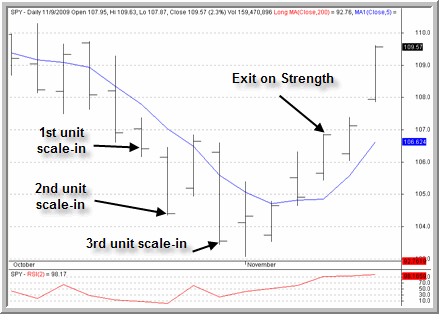Learn How to Trade ETF Funds Successfully: TPS and the Science of Scaling-In
Here’s the scenario: Your research into short term stock and exchange-traded fund (ETF) price behavior tells you that, under certain conditions, the lower the market goes, the more interested you should be in potentially buying it.
Assuming this is true (and it is, by the way), what is the best way to take maximum advantage of this data?
For Larry Connors and his team at Connors Research, the answer was clear: you buy more as the market moves lower, in particular, using a technique called “scaling-in”.
“Scaling-in” to trades as they move lower is one of the most unique aspects of Larry Connors’ high probability trading strategies for both stocks and ETFs. Based on research extending back to the mid-1990s in most stocks and since inception with most widely-traded exchange-traded funds, Larry Connors has shown that short term traders can potentially increase their per trade win-rates dramatically by using a variety of scale-in strategies that enable traders to take larger positions when the historical edges are on their side.
This trading strategy of scaling-in is so important that it represents a trading strategy – called the TPS Strategy – almost by itself.
How does scaling-in work?
There are a variety of scale-in trading strategies. But they all operate off the same basic premise: as a market becomes oversold, the strategy calls for buying one unit. As the market becomes even more oversold, scaling-in means buying additional units – sometimes in greater size.
Not only does this approach lower the cost basis of the trade, but scaling-in trading strategies ensure that a trader will typically have his or her largest position size at the point where the market – the stock or ETF – is at its most oversold, and most likely to make significant short term gains.

Above is an example of a three-part scale-in with the ^SPY^.
Here, the first long signal arrived on October 27th. Using a very, very basic scale-in strategy, a trader could have bought one unit on the 27th, a second unit long on October 28th as the SPY closed still lower, and a third and final unit long on October 30th.
At this point, the trader would long three units in the SPY: one at 106.42, one at 104.41 and a third at 103.56. The average cost would be 104.79.
Next, the trader simply waits to exit the position on strength. Using one of our primary exit strategies (a closing RSI in overbought territory), this trade would have been exited on November 5th at 106.85 for a gain of almost 2%.
To really understand the power of scaling-in, consider this: the first unit profit was only 0.04%. But the profit on the third and final unit scale-in was more than 3%. By scaling-in – adding additional positions as the market pulled back further and became more and more oversold, would have played a key role in making this trade a successful one.
These gains are magnified when traders, for example, add size as they add positions – for example, starting off with a 10% position and increasing each subsequent position by 10% (i.e., first unit 10%, second unit 20%, etc.)
If you would like to take advantage of high probability ETF trading strategies like these, click the link below to download, Learn How to Trade ETF Funds Successfully: An Introduction to Using TPS featuring our top short-term, scale-in ETF trading strategy: TPS.
David Penn is Editor in Chief at TradingMarkets.com.
